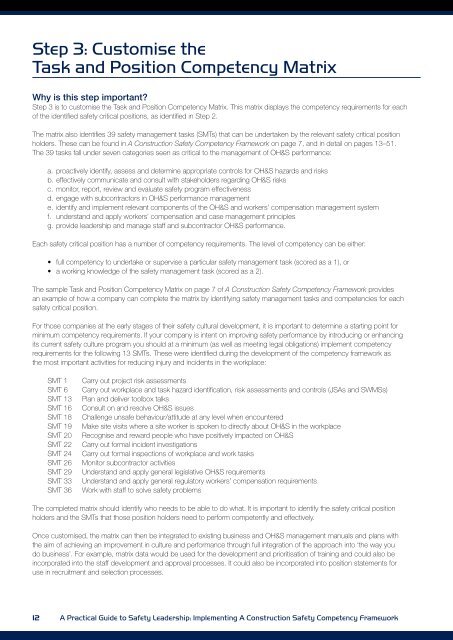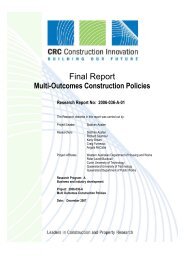A Practical Guide to Safety Leadership Book (PDF 5MB) - QUT ePrints
A Practical Guide to Safety Leadership Book (PDF 5MB) - QUT ePrints
A Practical Guide to Safety Leadership Book (PDF 5MB) - QUT ePrints
You also want an ePaper? Increase the reach of your titles
YUMPU automatically turns print PDFs into web optimized ePapers that Google loves.
Step 3: Cus<strong>to</strong>mise the<br />
Task and Position Competency Matrix<br />
Why is this step important?<br />
Step 3 is <strong>to</strong> cus<strong>to</strong>mise the Task and Position Competency Matrix. This matrix displays the competency requirements for each<br />
of the identified safety critical positions, as identified in Step 2.<br />
The matrix also identifies 39 safety management tasks (SMTs) that can be undertaken by the relevant safety critical position<br />
holders. These can be found in A Construction <strong>Safety</strong> Competency Framework on page 7, and in detail on pages 13–51.<br />
The 39 tasks fall under seven categories seen as critical <strong>to</strong> the management of OH&S performance:<br />
a. proactively identify, assess and determine appropriate controls for OH&S hazards and risks<br />
b. effectively communicate and consult with stakeholders regarding OH&S risks<br />
c. moni<strong>to</strong>r, report, review and evaluate safety program effectiveness<br />
d. engage with subcontrac<strong>to</strong>rs in OH&S performance management<br />
e. identify and implement relevant components of the OH&S and workers’ compensation management system<br />
f. understand and apply workers’ compensation and case management principles<br />
g. provide leadership and manage staff and subcontrac<strong>to</strong>r OH&S performance.<br />
Each safety critical position has a number of competency requirements. The level of competency can be either:<br />
• full competency <strong>to</strong> undertake or supervise a particular safety management task (scored as a 1), or<br />
• a working knowledge of the safety management task (scored as a 2).<br />
The sample Task and Position Competency Matrix on page 7 of A Construction <strong>Safety</strong> Competency Framework provides<br />
an example of how a company can complete the matrix by identifying safety management tasks and competencies for each<br />
safety critical position.<br />
For those companies at the early stages of their safety cultural development, it is important <strong>to</strong> determine a starting point for<br />
minimum competency requirements. If your company is intent on improving safety performance by introducing or enhancing<br />
its current safety culture program you should at a minimum (as well as meeting legal obligations) implement competency<br />
requirements for the following 13 SMTs. These were identified during the development of the competency framework as<br />
the most important activities for reducing injury and incidents in the workplace:<br />
SMT 1<br />
SMT 6<br />
SMT 13<br />
SMT 16<br />
SMT 18<br />
SMT 19<br />
SMT 20<br />
SMT 22<br />
SMT 24<br />
SMT 26<br />
SMT 29<br />
SMT 33<br />
SMT 36<br />
Carry out project risk assessments<br />
Carry out workplace and task hazard identification, risk assessments and controls (JSAs and SWMSs)<br />
Plan and deliver <strong>to</strong>olbox talks<br />
Consult on and resolve OH&S issues<br />
Challenge unsafe behaviour/attitude at any level when encountered<br />
Make site visits where a site worker is spoken <strong>to</strong> directly about OH&S in the workplace<br />
Recognise and reward people who have positively impacted on OH&S<br />
Carry out formal incident investigations<br />
Carry out formal inspections of workplace and work tasks<br />
Moni<strong>to</strong>r subcontrac<strong>to</strong>r activities<br />
Understand and apply general legislative OH&S requirements<br />
Understand and apply general regula<strong>to</strong>ry workers’ compensation requirements<br />
Work with staff <strong>to</strong> solve safety problems<br />
The completed matrix should identify who needs <strong>to</strong> be able <strong>to</strong> do what. It is important <strong>to</strong> identify the safety critical position<br />
holders and the SMTs that those position holders need <strong>to</strong> perform competently and effectively.<br />
Once cus<strong>to</strong>mised, the matrix can then be integrated <strong>to</strong> existing business and OH&S management manuals and plans with<br />
the aim of achieving an improvement in culture and performance through full integration of the approach in<strong>to</strong> ‘the way you<br />
do business’. For example, matrix data would be used for the development and prioritisation of training and could also be<br />
incorporated in<strong>to</strong> the staff development and approval processes. It could also be incorporated in<strong>to</strong> position statements for<br />
use in recruitment and selection processes.<br />
12 A <strong>Practical</strong> <strong>Guide</strong> <strong>to</strong> <strong>Safety</strong> <strong>Leadership</strong>: Implementing A Construction <strong>Safety</strong> Competency Framework

















